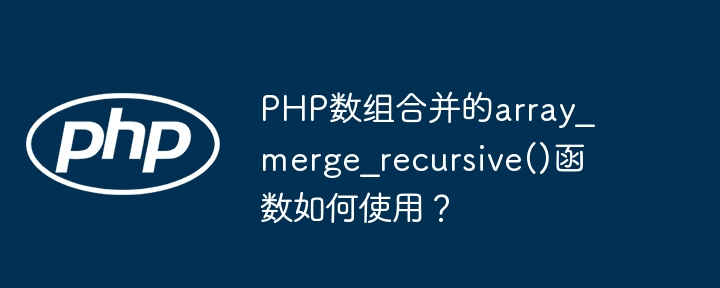Home >Backend Development >PHP Tutorial >How to use the array_merge_recursive() function of PHP array merging?
How to use the array_merge_recursive() function of PHP array merging?
- WBOYWBOYWBOYWBOYWBOYWBOYWBOYWBOYWBOYWBOYWBOYWBOYWBOriginal
- 2024-04-29 08:48:01538browse
array_merge_recursive() function recursively merges the keys and values in the array to create a new array. The syntax is array_merge_recursive(...$arrays), the parameter is the array list to be merged, and the return value is the merged new array. This function recursively processes nested arrays, with unique keys and overwritten values when merging.

PHP uses the array_merge_recursive() function to merge arrays
Introduction
array_merge_recursive() Function can be used to merge two or more arrays, it will recursively merge the keys and values in the arrays, thereby creating a new array.
Syntax
array_merge_recursive(...$arrays);
Where ...$arrays represents the array list to be merged.
Parameters
- $arrays: Array list to be merged
Return value
This function returns a merged new array.
Practical case
The following code example demonstrates how to use array_merge_recursive() Function:
<?php
// 创建两个数组
$arr1 = array("a" => "apple", "b" => "banana");
$arr2 = array("b" => "berry", "c" => "cherry");
// 使用 array_merge_recursive() 合并数组
$mergedArray = array_merge_recursive($arr1, $arr2);
// 打印合并后的数组
print_r($mergedArray);
?>Output:
Array
(
[a] => apple
[b] => berry
[c] => cherry
) Note:
-
array_merge_recursive()Arrays nested within arrays will be processed recursively when merging arrays. - If you want to make the keys in the merged array unique, you can use the
array_merge()function. - If you want to overwrite the values in the merged array, you can use the
array_replace_recursive()function.
The above is the detailed content of How to use the array_merge_recursive() function of PHP array merging?. For more information, please follow other related articles on the PHP Chinese website!

